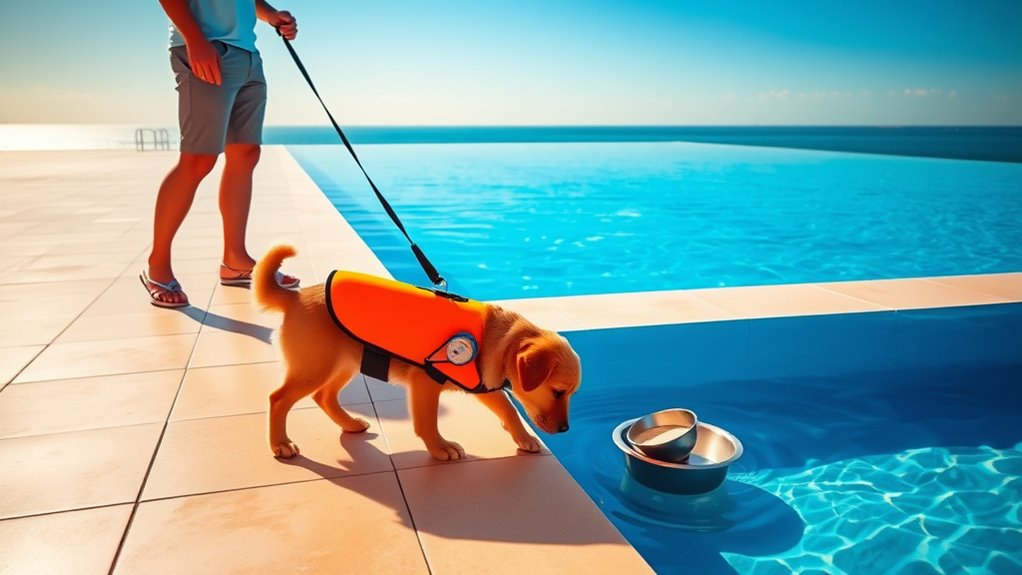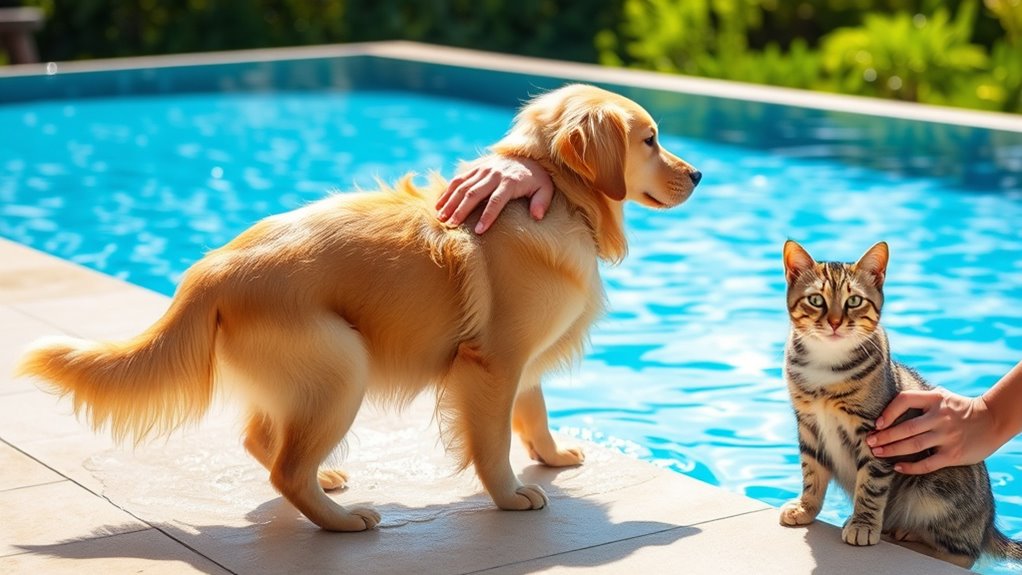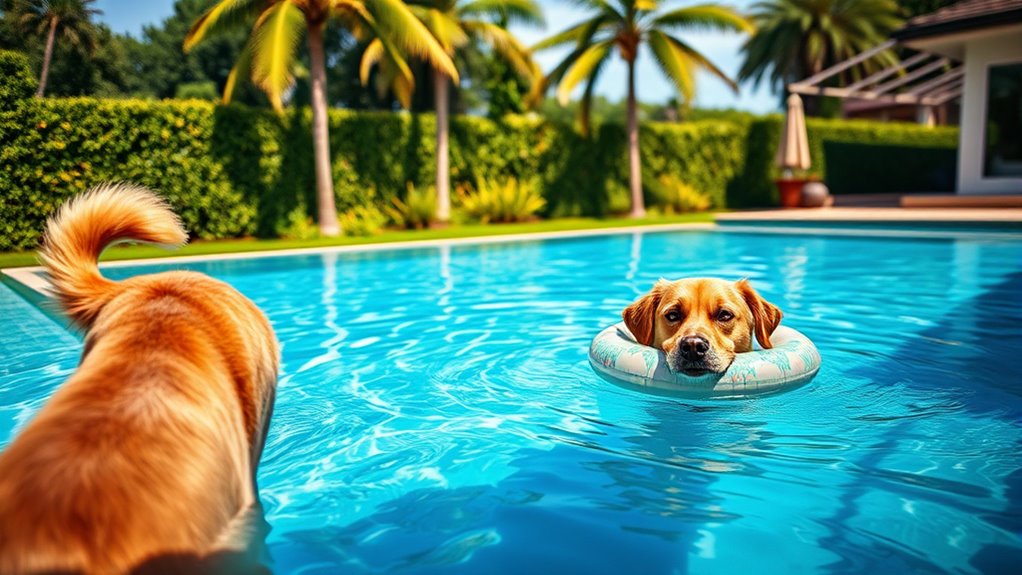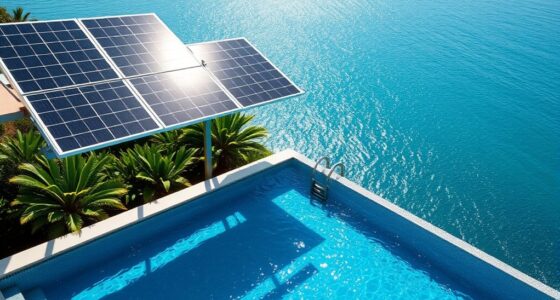To keep your pets safe around infinity pools, supervise them closely and use sturdy barriers like fences and gates to prevent unsupervised access. Train your pets to avoid the pool edges and recognize safe zones, and always monitor their behavior after swimming. Make sure safety equipment like alarms and covers are well-maintained. If you want to learn more about creating a safe pool environment for your furry friends, keep exploring these expert tips.
Key Takeaways
- Always supervise pets closely near infinity pools to prevent accidental slips or falls.
- Install secure fencing and tamper-proof gates around the pool area to restrict unsupervised access.
- Train pets to recognize safe zones and use positive reinforcement to reinforce boundaries.
- Regularly inspect and maintain safety equipment like alarms, covers, and fencing for optimal protection.
- Monitor pets after water exposure for signs of fatigue, irritation, or water intoxication and seek veterinary care if needed.
Supervising Pets Around the Pool

Because pets are naturally curious and playful, supervising them around the pool is essential to guarantee their safety. You need to watch them closely when they’re near the water, especially if they’re not familiar with pools or are hesitant swimmers. Never leave your pet unattended, even for a moment. They can easily slip or jump in unexpectedly, leading to potential drowning or panic. Keep an eye on their behavior—if they seem anxious or hesitant, intervene before they approach the edge. Use commands they recognize to keep them at a safe distance. Remember, pets often don’t understand the dangers of deep water, so your vigilance is key to preventing accidents and ensuring they stay safe and comfortable around the pool area. Supervision is crucial for preventing injuries and promoting safe water experiences for your pets.
Installing Barriers and Fencing

You need to install barriers that keep your pets safe around the pool, starting with secure gate locks to prevent accidental access. Make sure the fence height meets the recommended standards to stop pets from jumping over, and choose materials that are durable and non-toxic. Proper fencing is a critical step to guarantee your pets can enjoy the pool area safely. Additionally, considering emotional balance and stability in your overall safety plan can enhance your pet’s well-being around the pool environment.
Secure Gate Locks
Installing secure gate locks is essential for keeping pets safe around infinity pools. You want to prevent curious pets from slipping through or opening gates. Choose locks that are high enough, tamper-proof, and easy for you to operate but difficult for pets. Consider locking mechanisms that require a key or a combination to ensure added security. Regularly check and maintain your locks to ensure they work properly. To help you stay organized, here’s a quick overview:
| Lock Type | Key Features | Best For |
|---|---|---|
| Deadbolt Lock | High security, tamper-proof | Larger gates, main entrances |
| Magnetic Lock | Easy to operate, secure | Sliding gates, patio doors |
| Combination Lock | No keys needed, customizable | Gates with frequent access |
Implementing AI-powered security systems can further enhance safety by providing real-time alerts if gates are tampered with or left open. Secure locks keep your pet safe and peace of mind intact.
Fence Height Standards
Ensuring your fence is tall enough is essential for keeping pets safely contained around infinity pools. Most experts recommend a minimum height of 4 feet, but taller fences—up to 6 feet—offer better security for active or agile animals. Check local regulations, as some areas require specific fence heights for safety. You should also consider your pet’s size and jumping ability; larger or more energetic pets may need taller barriers. Make sure there are no footholds or horizontal rails that can be used as steps. Regularly inspect the fence for damage or gaps that could allow your pet to escape. Proper fencing acts as a reliable physical barrier, preventing pets from accessing the pool area unsupervised and reducing the risk of accidents. Remote work can increase flexibility, making it easier for pet owners to supervise their animals around pool areas.
Material Safety Considerations
Choosing the right materials for your fencing is crucial to guarantee it remains safe and durable around infinity pools. You want materials that withstand weather, resist corrosion, and avoid splintering or breaking easily. Metal fences, like aluminum or stainless steel, are excellent because they’re strong, rust-resistant, and require minimal maintenance. Vinyl fencing is another safe option—it’s durable, non-toxic, and easy to clean. Avoid wood or other porous materials that can degrade faster or harbor mold. Also, ensure the fencing has no sharp edges or splinters that could injure your pets. Properly installed, sturdy barriers made from safe materials help prevent accidental falls and provide peace of mind, so your pets can enjoy the pool area safely. Additionally, selecting high-contrast, reflective surfaces can improve visibility and safety around the pool zone.
Training Pets to Avoid Pool Edges

You need to supervise your pet whenever they’re near the pool to prevent accidents. Using positive reinforcement helps teach them to stay away from the edges safely. Consider creating designated safe areas around the pool to keep your pet protected. Additionally, understanding Gold IRA fees can help ensure your investments are managed cost-effectively, reducing unnecessary expenses.
Supervise Pool Access Carefully
Since pets can be curious and quick to explore, supervising their access to the pool is essential to prevent accidents. Always keep a close eye when your pet is near the water, especially if they haven’t learned to stay away from the edges. Use barriers like gates or fences to restrict unsupervised access, and never leave them alone near the pool area. Be vigilant for signs of distress or hesitation, and intervene immediately if they get too close or seem unsure. Remind yourself that even confident swimmers can become overwhelmed or distracted. Regularly supervise your pet during pool visits, and stay nearby so you can respond quickly if needed. Consistent supervision minimizes risks and helps your pet develop safe habits around water. Incorporating supervision strategies can further enhance safety and prevent potential accidents.
Use Positive Reinforcement Techniques
Training your pet to avoid pool edges is an effective way to enhance safety around the water. Use positive reinforcement techniques to encourage good behavior. When your pet stays away from the pool edge, reward them immediately with treats, praise, or playtime. Consistently redirect their attention whenever they approach the edge, and reward them when they move away. Avoid punishment, as it can create fear and confusion. Instead, focus on rewarding calm, safe behaviors. Practice these cues regularly in a controlled environment before applying them near the pool. Over time, your pet will associate staying clear of the edge with positive outcomes. Creating a safe environment prevents accidents and helps your pet understand boundaries, reducing the risk of accidents during pool visits.
Designate Safe Pool Areas
Establishing designated safe areas around the pool helps your pet understand where they can relax and play without risking an accident near the edges. Use visual markers like mats or rugs to create a clear boundary, so your pet recognizes this is a safe zone. Consistently guide your pet to these areas during playtime, especially before they become overly excited. Reinforce positive behavior by praising them when they stay within the safe zone. Avoid letting your pet roam unsupervised near the pool edges, as they might accidentally slip or jump in. Training your pet to stay within designated zones reduces their chances of falling into the water unexpectedly. Clear boundaries and consistent reinforcement help your pet feel secure and aware of safe spaces around the pool. Incorporating mindfulness practices into your training can further enhance your pet’s awareness and safety near water.
Providing Safe Access to the Water

Ensuring pets can access infinity pools safely requires thoughtful design and proactive measures. Install a gentle, slip-resistant ramp or steps designed specifically for pets, making it easier for them to enter and exit the water comfortably. Keep the pool area enclosed with a secure fence to prevent accidental falls or unsupervised access. Consider adding a pool cover or barrier that allows pets to reach the water when needed but blocks their entry when unsupervised. Always supervise your pet around the pool, especially during initial access attempts. Teach your pet to use designated entry points calmly. Regularly check that these access points are in good condition, free of algae or debris, and sturdy enough to support your pet’s weight. This approach helps keep your furry friend safe while enjoying the pool. Digital literacy programs can also be helpful in educating pet owners about safe practices around water.
Recognizing Signs of Water Intoxication

While taking steps to provide safe access to the pool is vital, it’s equally important to watch for signs your pet might be overexposed to water. Water intoxication occurs when your pet ingests too much water, causing an imbalance in electrolytes. Look for excessive drooling, vomiting, or lethargy, which could indicate distress. You might notice your pet stumbling or having trouble standing, signaling confusion or weakness. Seizures or tremors are serious signs that require immediate attention. Pay attention to rapid breathing or a bloated abdomen, as these can also be symptoms. If you observe any of these signs, act quickly by removing your pet from the water and seeking urgent veterinary care. Early recognition can prevent severe complications and save your pet’s life.
Maintaining Pool Safety Equipment

Regularly checking and maintaining your pool safety equipment is essential to keep both your pets and family safe. Ensure that safety covers, alarms, and fencing are in excellent condition and functioning properly. Replace damaged or worn-out gear immediately to prevent accidents. Keep rescue equipment, like life rings and poles, accessible and in good shape. Regular inspections help you identify potential hazards before they become serious problems. Use the table below to understand the significance of well-maintained safety gear:
| Equipment | Purpose | Maintenance Tip |
|---|---|---|
| Pool Cover | Prevents accidental falls | Check for tears and debris |
| Safety Alarms | Alerts of unauthorized access | Test weekly and replace batteries |
| Fencing | Restricts pet access | Inspect for gaps and stability |
| Rescue Devices | Aid in emergencies | Ensure visibility and accessibility |
| Drain Covers | Prevent entrapment | Confirm secure and undamaged |
Regularly Monitoring Pet Health After Pool Use

After your pet finishes swimming or playing near the pool, closely observe their behavior and physical condition. Watch for signs of fatigue, limping, or unusual behavior that might indicate injury or exhaustion. Check their coat and skin for signs of irritation or redness, especially around the paws and ears. Monitor their breathing and look for coughing or wheezing, which could signal water inhalation or distress. Keep an eye out for any vomiting or diarrhea, as these may suggest ingestion of pool water or illness. Regularly inspecting your pet helps catch health issues early and guarantees their safety.
- Check for cuts or abrasions
- Observe breathing and energy levels
- Look for signs of water ingestion
- Monitor for skin irritations
- Watch for unusual behaviors
Frequently Asked Questions
What Types of Pets Are Most at Risk Around Infinity Pools?
Dogs are most at risk around infinity pools because they tend to be curious and may accidentally fall in or slip on the wet surfaces. Smaller pets like cats and rabbits can also be vulnerable if they wander too close to the edge. You should always supervise your pets near pools, install barriers or covers, and make sure they know not to approach the water to keep them safe.
How Often Should I Schedule Veterinary Check-Ups After Pool Exposure?
You should schedule veterinary check-ups for your pet within 24 to 48 hours after pool exposure, especially if they show any signs of distress or illness. Regular check-ups every six months are recommended for ongoing health monitoring. If your pet swims often or has had recent pool contact, ask your vet for personalized advice. Prompt vet visits guarantee early detection of potential health issues caused by pool chemicals or accidental ingestion.
Are There Specific Breeds More Prone to Water-Related Accidents?
Certain breeds, like retrievers, spaniels, and water-loving terriers, tend to be more prone to water-related accidents because of their natural affinity for water. However, any dog can get into trouble if unsupervised around pools. You should always supervise your pet near water, regardless of breed, and consider safety measures like barriers or life jackets to prevent accidents and guarantee their safety during pool visits.
Can Certain Pool Chemicals Harm Pets if Ingested or Contacted?
Yes, certain pool chemicals can harm your pets if ingested or contacted. Chlorine, bromine, and algaecides are common culprits that can cause irritation, poisoning, or other health issues. Always keep chemicals out of your pet’s reach, store them securely, and rinse your pet with freshwater if they contact these substances. Regularly check your pool and chemical storage areas to prevent accidental exposure and guarantee your pet’s safety.
What Emergency Steps Should I Take if My Pet Falls Into the Pool?
If your pet falls into the pool, act fast—don’t wait for a swim meet. Remove them immediately, and if they’re struggling, gently but firmly lift them out. Check for signs of distress or injury, like choking or unresponsiveness. Call your vet right away, and keep them warm and calm. Remember, a quick response can turn a potential disaster into a simple rescue—your pet’s safety is worth every second.
Conclusion
Keeping your pets safe around infinity pools isn’t just about precautions—it’s about peace of mind. By supervising them, installing barriers, and staying alert to signs of distress, you create a safer environment for everyone. Regularly check their health after swimming, and make certain safety equipment is ready. After all, isn’t their happiness and well-being worth a little extra effort? Follow these tips, and you can enjoy pool days together without worry.










